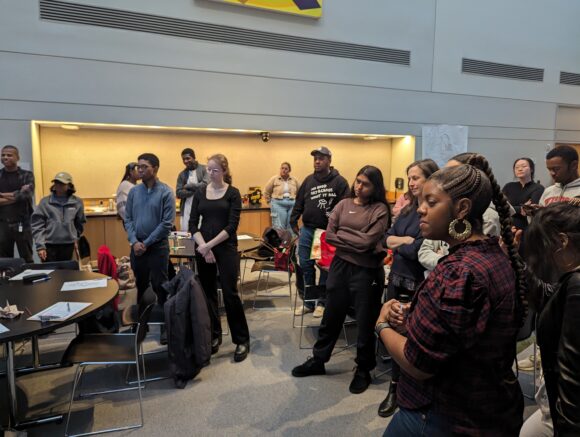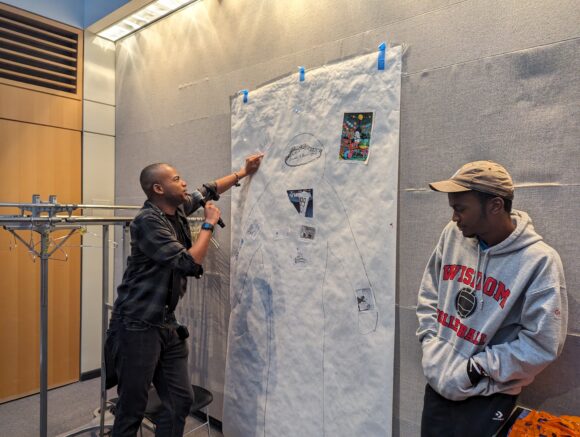A new year always means opportunities for reflection. For the CUNY Peer Leaders, it is an opportunity to tap into embodied experiences. On February 2, 2024, the current cohort of CUNY Peer Leaders gathered in the Graduate Center’s Skylight Room. Despite the rainy afternoon, we eagerly welcomed our students to participate and share in this engaging workshop.
Our meetings always begin with a check-in question/activity facilitated by CPL director Lauren Melendez. I appreciate these introductory moments with the group as students filter in and update us on how they feel in the present moment. Because this meet-up was about self-actualization and reflection, easing our students with the task of creating a poem as a check-in question is a great starting point. Lauren Melendez provided a template poem for students to think about who they are while creating a space for self-affirmation. The “I AM” poem aims to have writers think about how they characterize themselves while also making connections to the five senses. At the end of every stanza, writers repeat the same “I am____,” filling in the space with a core affirmation that creates an empowering feeling for everyone in the room. This written approach to reflective thought and self-understanding puts the wheels in motion for the following activity. I encourage readers to develop their “I am” poem on a coffee break or train commute. These moments of asking and knowing who we are in the present moment are imperative and do not often get asked anymore.
I Am
I am (two characteristics about yourself)
I wonder (something about which you are curious)
I hear (an imaginary sound)
I see (an imaginary sight)
I want (an actual desire)
I am (the first line repeated)
I pretend (something that you pretend to do)
I feel (a feeling about something)
I touch (an imaginary touch)
I worry (something about which you worry)
I cry (something that makes you sad)
I am (the first line repeated)
I understand (something you know to be true)
I say (something in which you believe)
I dream (something about which you dream)
I try (something toward which you make an effort)
I hope (something for which you hope)
I am (the first line repeated)
At last, we got to one of my favorite sessions in all of the CUNY Peer Leader workshops: Body Mapping or Body Mind Mapping. I was first introduced to Body Mind Mapping at the MURAP 2019 Conference at UNC-Chapel Hill. A group of researchers talked about using Body Mind Mapping to find a deeper connection to Colombia’s Latin American and Indigenous communities. I remember seeing photographs of community members’ bodies traced on giant white paper. These outlined bodies were then decorated with various crafts and colors that detailed the stories, lived experiences, and trauma they carried in such an artistic way.
Body Mind Mapping was developed in 2008 with the Canadian AIDS Treatment Information Exchange and the Regional Psychosocial Support Initiative in South Africa. To understand and navigate stigmas on HIV/AIDS, Body Mind Mapping aimed to recognize and elevate the stories and experiences of those diagnosed. Since then, activists have developed workshops on body mapping for health, wellness, and experiences.
After diving into more research, I also learned that the Body Mapping practices were inspired by indigenous and feminist epistemologies coming from Latin America, specifically the Xhinka women in Guatemala. The concept is called “Cuerpo- Territorio” or “Body- Territory.”
What started as a conceptualization of defense for women facing violence, especially sexual violence, has expanded to the practice and process of understanding the body as a territory in connection to the land (Cabnal 2020). Cuerpo-Territorio is connected to the land and thrives on ancestral healing. Cuerpo-Territorio is an indigenous conceptualization that has enabled indigenous communities to create platforms of representation and change. This conceptualization includes animals, humans, elements in nature, and spirits. It is these interactions that understand the complexity of the self. It is an understanding of how body, land, and territories are not solely understood based on unification and camaraderie. An “articulation of diversity” is a significant lesson that strengthens our relationship with Cuerpo-Territorio. It is a complex arrangement of negotiation and interaction with biotic and abiotic elements, but making these connections and returning to land is essential. Building on Cuerpo-Territorio, Body-Mind mapping functions as an “Arts-based research tool” within academic settings. Cuerpo-Territorio as a conceptualization has opened avenues of interpretation for other Latin American communities to use a Body-Mapping practice to indicate the territorial struggles faced by the communities (Svampa 2021:18). Mapping practices have been engaged in Ecuador, Mexico, Spain, Brazil, Uruguay, and Peru.
When I came across Body Mind Mapping, I saw this as an essential opportunity to highlight the experiences of my students, dive into pedagogical practices that were different from conventional traditions of learning and documentation, and show a creative outlet where students could feel connected and empowered with their bodies. I use body mapping as a leadership exercise and an icebreaker to learn about my students and peers. As a participant in these activities, I also reflect on my own conceptualizations of my identity and aspirational goals. Nothing about being human is static. Therefore, I encourage those facilitating the activity also to participate. The self-reflection is worth it and illuminating. Students work together by having a partner trace the outline of their bodies on a giant piece of paper. If students are not comfortable with this, we also have the option to use a printable version of a body on standard-sized paper.
I developed a series of guiding questions for the CUNY Peer Leaders that encouraged an open dialogue with their body-mind maps. Abstract interpretation is encouraged. Our overall goal is for participants to describe on their bodies who they are, what they are feeling, what they desire, and what they hope for. Here are a few examples:
- Write down your name anywhere on your body map. What do you like people to call you? How do YOU spell it? How do YOU pronounce it? Do you have any nicknames? Or specific ways of spelling?
- Loaded question: Where are you from? Think about space, city, and any location that YOU feel represents where you are from. This can be cultural, too. Maybe you’re from many places? What does that look like?
- What brings you peace? What are some things that make you feel relaxed and with yourself? I.e., reading a book, playing an instrument, or bubble baths? What are some spaces that break your peace or make you feel relaxed?
Over the years, the questions have developed or expanded. Students can share as much as they want, depending on the group. The group is encouraged to bring crafts and colored pencils to make the activity as mixed-media and sensory as possible. With the CPL, we did this and had our students bring newspaper clippings, magazines, pom poms, colorful paper, and glitter. My goal is to get us “back to Kindergarten.” Hands-on activities are rare in the collegiate setting, yet truly memorable.
For this session, we were thrilled to see the approaches taken to questions related to “where are you from” or developing an appreciation of their gender identities. We had students draw up their home country’s flag and create tree roots as the flag pole to represent their homeland and a reference of origin. Other students used magazine and newspaper clippings to describe their role in their family dynamics, as in the youngest or oldest sibling. Of course, for our students who are Native New Yorkers, symbols like the Yankees cap, skyscrapers, street names, and avenues made an appearance on several body maps. Body mapping is an excellent opportunity for participants to ask themselves questions and abstractly describe the importance connected to their bodies. As participants, it is a moment of self-reflection and perhaps even goal setting, as several students might even express the aspirations and dreams they desire for themselves, revealing what brings joy and excitement in a complex world. This is a beautiful opportunity for educators like me to understand who my students are and want to become. The use of color and textures ties back to my home and public school schooling, reminding me that even at this stage in academia, there doesn’t have to be a loss in creativity. Research and human engagement is a complex and creative process worth sharing.








Comments are closed.